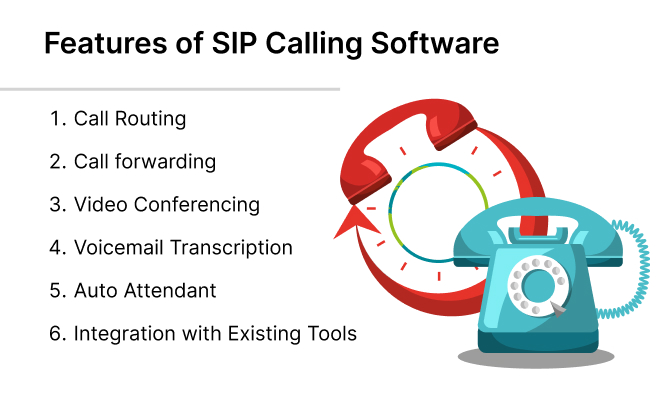
The communication landscape is rapidly evolving. Businesses often equate upgrading to newer technologies with substantial price tags and complex installations. However, the cloud has brought a game changer that has completely altered this dynamic. It’s SIP calling, i.e., Session Initiation Protocol calling. You can think of SIP calling as the best communication upgrade SMEs can give to their communication systems. From seamless collaboration without bothering about location to enjoying crystal clear calls without investing in expensive phone lines – that’s SIP calling for you!
Today, SIP calling has become a trend that is growing at lightning speed. The SIP market is projected to reach a whopping $40.77 billion by 2030, which is a clear indication of its rising popularity.
Curious to learn more about SIP calling?
In this blog, I’m going to explain SIP calling, how it works, which businesses can benefit from it, and some practical use cases.
Let’s begin!
What is SIP Calling?
Let’s begin with SIP, i.e., Session Initiation Protocol. It’s a signaling protocol that performs the function of controlling communication sessions. It initiates, manages, and terminates voice calls over the internet. Though it doesn’t handle voice data itself, it rather establishes the connection and ensures all the elements work together smoothly. Most commonly, SIP is associated with VoIP calls; however, it also goes beyond that. SIP can also be used to manage other forms of communication, such as video conferencing and instant messaging.
Now let’s move ahead to SIP calling. You can simply think about virtual phone lines, just like VoIP, allowing you to make and receive calls over your existing internet connection. As the term suggests, SIP calling makes use of the Session Initiation Protocol, or SIP, to execute communication sessions over the internet.
When using SIP calling, you can forget the need for bulky phone hardware and physical copper wires for making connections. This is because with SIP, everything works over the Internet. Legacy phone systems use physical copper wires to send calls to PSTN, i.e., the Public Switched Telephone Network. In SIP calling, the same is done using SIP trunks. These trunks are specific connections that link your PBX system to the PSTN using SIP.
Features of SIP Calling Software
In terms of functionality, SIP calling boasts a range of features that can transform the way your teams connect. Here’s a closer look at each of the features:

Call Routing
This is a great feature that allows you to route calls based on various factors such as the skills of the agents, the time at which the call arrives, the specific extension dialed by the caller, etc. Such intelligent routing of calls streamlines the overall call flow, makes sure that customers get connected to the right destination, and saves time for both callers and agents.
Call Forwarding
It may seem like an ordinary calling feature, but when utilized effectively, it can offer a lot of value. Suppose when you are already on a call, then the incoming call can be forwarded to another agent or extension, or voicemail, or even another phone number. The benefit is that you never miss a call, and your callers always have a way to reach someone.
Video Conferencing
Besides voice calls, SIP calling facilitates you to host face-to-face meetings virtually. This is especially helpful when you want to seamlessly connect with remote colleagues and overseas clients despite the physical distance. There is no need for expensive travel, as you can connect with them in real-time.
Voicemail Transcription
Often, agents spend a lot of time deciphering voicemail messages that affect their productivity. Voicemail transcription is an effective solution to this problem. SIP voicemail messages get transcribed into text, which means you can quickly scan the content and respond accordingly.
Auto Attendant
Auto attendants are often used as the first point of contact for customers or callers. From greeting the callers with a personalized message, providing them with menu options, and directing them to the correct destination, auto attendants do it all. A major benefit of auto attendants is that they eliminate the dependency of a human receptionist and minimize the number of errors as well.
Benefits of SIP Calling
Cost Efficiency
Traditional phone lines require significant upfront investment in physical infrastructure for installing PBX systems, dedicated phone lines, and maintenance. In the case of SIP calling, there is no such investment required since it relies on the internet and software-based solutions. Startups with limited budgets and resources can benefit significantly by avoiding a thousand-dollar upfront investment in traditional PBX systems and adopting SIP calling, which only requires a stable internet connection and compatible phones.
Moreover, SIP calling dramatically reduces the cost of making calls, especially long distance and international ones. According to tech.co, small businesses that switch to SIP calling reduce the cost of their local calls by up to 40%, and save up to 90% on international calls.
While traditional phone lines charge per minute for long-distance calls, SIP comes with the advantage of no additional per-minute charges. This means that if you are a company with offices in New York and London spending $3500 monthly on international calls, then by switching to SIP calling, you may be able to drop your bill by $500 because calls are routed over the internet at no extra cost.
Increased Flexibility and Scalability
SIP calling allows businesses to instantly scale their phone systems up or down as required, without any hassle of additional hardware installation. Adding or removing new phone lines is as simple as configuring the software. So companies that need to quickly add additional phone lines can do so within a short period of time and without any physical installations.
SIP calling also supports remote work, i.e., employees can use SIP calling from anywhere with an active internet connection. This is especially useful for modern businesses that foster remote work setups.
Advanced Features and Productivity
SIP calling comes with a suite of features like call forwarding, voicemail transcription, call recording, conference calling, auto-attendants, etc. These features enhance the overall efficiency, call management, and customer experience. SIP calls are often better in quality, both audio and video, as compared to traditional calls.
Suppose you have a customer service center, and you recently implemented call forwarding and auto attendant features. By doing this, you ensure that all the incoming calls are directed to the right destinations, reducing wait times for customers.
Which Companies Use SIP Calling?

SIP calling can be used by any company, big or small, that wishes to enjoy the above mentioned benefits. Be it lesser international calling charges, remote work enablement, or scalability, SIP calling can pay off in numerous ways. In 2022, SIP accounted for more than 60% of all business voice traffic.
Companies that have already invested in an on-premise PBX system or an IP-PBX can also reap the benefits of SIP calling. This can be done by taking their PBX to the cloud. It is important to recognize that delaying your transition from on-premise to cloud can ultimately lead to higher operational expenses.
Business Use Cases of SIP Calling
Customer Call Center
Call centers often receive a high volume of inbound and outbound calls, and SIP calling can help efficiently handle such traffic. Advanced features offered by SIP calling, such as IVR, call recording, call forwarding, etc., help in call handling, thus elevating customer satisfaction.
Small and Medium-Sized Enterprises (SMEs)
Businesses that are small in size, such as startups, often have limited resources and budget constraints. They need a system that can grow with them without making significant investments in infrastructure. SIP calling fits in as the perfect solution for such growing enterprises, offering scalability, flexibility, and cost-effectiveness.
Organizations Fostering Remote Work
Several organizations around the world are enforcing remote work models, especially post Covid pandemic. These companies can use SIP calling to maintain seamless internal and external communication.
Difference Between SIP and VoIP?
Both terms are related to internet-based communication and are often used interchangeably, however, these two represent different usages. SIP is actually one of the primary protocols used to achieve VoIP. To put it more simply, we can say that VoIP is the concept of using internet technology for voice communication. While SIP is the specific method used to establish and manage those voice calls.
SIP Calling vs. Landlines
Landlines are old-school. We are in the 2020s, and it’s hard to take the hassle of complex installations, physical wires, equipment, and maintenance. Contrarily, SIP calling is simple to set up and uses your existing internet connection; it’s a streamlined approach to communication. Let’s understand their key differences, as outlined in the below table.
SIP Calling vs. WiFi Calling
The comparison between SIP calling and WiFi calling is quite interesting because both leverage internet technology to enable voice communication. However, both technologies differ in terms of scope, features, and target users. Let’s understand them with the help of examples.
WiFi calling is a feature offered by mobile carriers using which users can make and receive calls over a WiFi network, just like they rely on their cellular network service. Suppose you are in a hotel basement where you experience poor cellular reception. But the hotel has strong WiFi, which means you can still easily make and receive calls without worrying about any interruption.
Talking about SIP calling, it enables voice communication over any type of internet connection, not just WiFi. Suppose you are a company using a VoIP phone system to handle customer calls. You can use SIP calling to route your calls, adding efficiency and cost-effectiveness.
In essence, WiFi and SIP calling enhance communication by leveraging internet technology, however, they are tailored for different uses. WiFi is a specific feature more suitable for individuals looking to improve call quality and connectivity in areas with poor cellular coverage. In contrast, SIP is a comprehensive solution ideal for business environments where more flexibility and features are required.
How to Set up SIP Calling?

So if you have decided to use SIP calling for your business communication, then you start setting up by choosing a SIP provider. It is best to research and select a few reliable providers that fit your specific needs. Then consider factors like price, features, customer support, and scalability.
The next phase is about getting SIP-compatible hardware or software. You may want to use SIP phones, which are dedicated devices designed to work with SIP. Some popular options include Cisco, Yealink, etc. You may also want to get software-based applications to be used on your computer or smartphone. If you want to connect your analog phones to your SIP network, then you will need an ATA, i.e. Analog Phone Adapter.
Before you start accessing your SIP device or softphone, some important considerations to be made are:
- Ensure a stable, high-speed internet connection for optimal SIP call quality.
- Configure your router to prioritize VoIP traffic to prevent call quality issues.
- Make sure your firewall allows SIP traffic to pass through. You can do this by opening the necessary ports (typically, UDP ports 5060-5061 and RTP ports 10000-20000).
In the next phase, you need to use your SIP credentials, which you have received from your chosen SIP provider. Input these credentials, such as username, password, and SIP address, on your SIP device or softphone. For configuration, you can follow the specific instructions provided by the device manufacturer. You may also set additional features such as voicemail transcription, call forwarding, and auto attendant.
Now, your SIP device is ready to be tested for calls. You can start by making a test call to ensure everything is configured correctly. Remember to verify the call quality, audio clarity, and feature functionality.
The Future of SIP Calling
As technological advancements continue to transform the communication landscape and more businesses seek cost-effective, flexible, and scalable communication solutions, the future of SIP calling seems bright and promising. SIP calling will continue to offer businesses with more innovative and efficient communication solutions.
With the integration of smart technologies such as AI into the SIP calling systems, we can expect calls to be smarter than ever before. Imagine being answered by robots who understand your specific needs. Augmented reality and virtual reality are two other powerful technologies that can integrate into SIP calling and revolutionize the customer support landscape.
Wrapping Up: Are You Ready for SIP Calling?
With SIP calling, you can see the things you’ve only imagined turning into reality. By leveraging the internet for voice and video calls, organizations can achieve seamless connectivity, enhance collaboration, and streamline their communication infrastructure.
Frequently Asked Questions
Can existing business phones be used with SIP calling?
Yes, by using an Analog Telephone Adapter or ATA you can use your existing business phones with SIP calling.
What is the difference between SIP trunking and SIP calling?
SIP trunking refers to the method of connecting a PBX system to the internet using SIP. On the other hand, SIP calling is the technology used to make phone calls over the internet.
How can I use SIP calling on my mobile phone?
Most of the SIP service providers offer mobile apps that allow you to make and receive SIP calls on your smartphones.
Does poor internet quality affect SIP call quality?
Yes, unstable or poor internet can impact SIP call quality through issues like echo, dropped calls, etc.
What factors affect the cost of SIP calling?
The cost of SIP calling is determined by various factors such as number of users, required features, call volume and the chosen SIP provider.






















